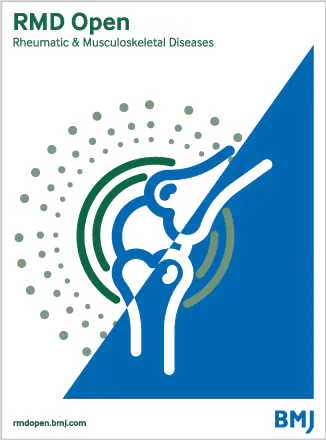What role do socioeconomic and clinical factors play in disease activity states in rheumatoid arthritis? Data from a large UK early inflammatory arthritis audit
IF 5.1
2区 医学
Q1 RHEUMATOLOGY
引用次数: 0
Abstract
Background Persistently active rheumatoid arthritis (pactiveRA) may be due to the interplay between biological and non-biological factors. The role of socioeconomic factors remains unclear. Objectives To explore which biological and non-biological factors associate with pactiveRA. Methods Adults with early RA in the National Early Inflammatory Arthritis Audit, recruited from May 2018 to October 2022, were included if having pactiveRA or persistently low RA (plowRA). The pactiveRA was defined as three consecutive Disease Activity Score-28 joints (DAS28) of >3.2 at baseline, 3 and 12 months. The plowRA was defined as DAS28 ≤3.2 at 3 and 12 months. Stepwise forward logistic regression was used to explore associations with pactiveRA (outcome). Age and gender were included a priori, with socioeconomic factors and comorbidities as exposure variables. Results 682 patients with pactiveRA and 1026 plowRA were included. Compared with plowRA, patients with pactiveRA were younger (58, IQR: 49–67) versus (62, IQR: 52–72), and included more women (69% vs 59%). The pactiveRA was associated with worse scores in patient-reported outcomes at baseline, and anxiety and depression screens. Overall, there was clear social patterning in pactiveRA, with age-by-gender interaction. Logistic regression indicated age, gender, social deprivation and previous or current smoking, were independently associated with pactiveRA, after controlling for disease severity markers (seropositivity). Depression, lung disease, gastric ulcers and baseline corticosteroid use, were also associated with pactiveRA (p<0.05 for all). Conclusion Socioeconomic factors and deprivation were associated with pactiveRA, independent of clinical and disease characteristics. Identifying ‘adverse’ socioeconomic drivers of pactiveRA can help tailor interventions according to individual need. Data are available upon reasonable request. Data used in this study were collected for the National Early Inflammatory Arthritis Audit and are available on request to the data controllers (the Healthcare Quality Improvement Partnership). Data are available upon reasonable request by any qualified researchers who engage in rigorous, independent scientific research, and will be provided following review and approval of a research proposal and Statistical Analysis Plan and execution of a Data Sharing Agreement. All data relevant to the study are included in the article. All figures and tables included in this article are original.社会经济因素和临床因素在类风湿关节炎的疾病活动状态中扮演什么角色?来自英国大型早期炎症性关节炎审计的数据
背景持续活动性类风湿性关节炎(pactiveRA)可能是生物和非生物因素相互作用的结果。社会经济因素的作用尚不明确。目的 探讨哪些生物和非生物因素与持续活动性类风湿关节炎有关。方法 在2018年5月至2022年10月期间招募的全国早期炎症性关节炎审计中,如果患有pactiveRA或持续低RA(plowRA),则纳入患有早期RA的成人。pactiveRA的定义是在基线、3个月和12个月时连续三次疾病活动度评分-28关节(DAS28)>3.2。犁式RA的定义是在3个月和12个月时DAS28≤3.2。采用逐步前向逻辑回归法探讨与pactiveRA(结果)的关联。年龄和性别为先验变量,社会经济因素和合并症为暴露变量。结果 纳入了 682 名 pactiveRA 患者和 1026 名 plowRA 患者。与犁式 RA 相比,pactiveRA 患者更年轻(58 岁,IQR:49-67),犁式 RA 患者更年轻(62 岁,IQR:52-72),女性患者更多(69% 对 59%)。pactiveRA 与患者报告的基线结果、焦虑和抑郁筛查得分较低有关。总体而言,pactiveRA 存在明显的社会模式,年龄与性别之间存在交互作用。逻辑回归结果表明,在控制了疾病严重程度指标(血清阳性)后,年龄、性别、社会贫困程度、以前或现在吸烟与 pactiveRA 有独立的相关性。抑郁、肺部疾病、胃溃疡和基线皮质类固醇的使用也与 pactiveRA 有关(均 p<0.05)。结论 社会经济因素和贫困与 pactiveRA 有关,与临床和疾病特征无关。找出导致 pactiveRA 的 "不利 "社会经济因素有助于根据个人需求制定干预措施。如有合理要求,可提供相关数据。本研究中使用的数据是为全国早期炎症性关节炎审计收集的,可向数据控制者(医疗质量改进合作组织)索取。任何从事严谨、独立科学研究的合格研究人员在提出合理要求后均可获得数据,并将在审查和批准研究提案和统计分析计划以及签署数据共享协议后提供数据。所有与研究相关的数据都包含在文章中。本文中的所有图表均为原创。
本文章由计算机程序翻译,如有差异,请以英文原文为准。
求助全文
约1分钟内获得全文
求助全文
来源期刊

RMD Open
RHEUMATOLOGY-
CiteScore
7.30
自引率
6.50%
发文量
205
审稿时长
14 weeks
期刊介绍:
RMD Open publishes high quality peer-reviewed original research covering the full spectrum of musculoskeletal disorders, rheumatism and connective tissue diseases, including osteoporosis, spine and rehabilitation. Clinical and epidemiological research, basic and translational medicine, interesting clinical cases, and smaller studies that add to the literature are all considered.
 求助内容:
求助内容: 应助结果提醒方式:
应助结果提醒方式:


